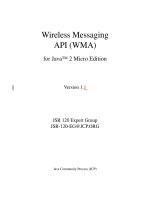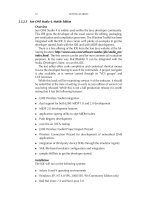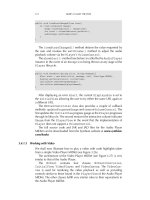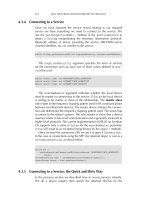Wireless Messaging API (WMA) for Java™ 2 Micro Edition potx
Bạn đang xem bản rút gọn của tài liệu. Xem và tải ngay bản đầy đủ của tài liệu tại đây (368.05 KB, 54 trang )
Wireless Messaging
API (WMA)
for Java™ 2 Micro Edition
Version 1.1
JSR 120 Expert Group
Java Community Process (JCP)
ii
Copyright © 2002 Sun Microsystems, Inc., 901 San Antonio Road, Palo Alto, California 94303, U.S.A. All
rights reserved.
Sun Microsystems, Inc. has intellectual property rights relating to technology embodied in the product that is
described in this document. In particular, and without limitation, these intellectual property rights may include
one or more of the U.S. patents listed at and one or more additional patents or
pending patent applications in the U.S. and in other countries.
This document and the product to which it pertains are distributed under licenses restricting their use, copying,
distribution, and decompilation. No part of the product or of this document may be reproduced in any form by
any means without prior written authorization of Sun and its licensors, if any.
Third-party software, including font technology, is copyrighted and licensed from Sun suppliers.
Sun, Sun Microsystems, the Sun logo and Java are trademarks or registered trademarks of Sun Microsystems,
Inc. in the U.S. and other countries.
Federal Acquisitions: Commercial Software - Government Users Subject to Standard License Terms and
Conditions.
DOCUMENTATION IS PROVIDED "AS IS" AND ALL EXPRESS OR IMPLIED CONDITIONS,
REPRESENTATIONS AND WARRANTIES, INCLUDING ANY IMPLIED WARRANTY OF
MERCHANTABILITY, FITNESS FOR FOR A PARTICULAR PURPOSE OR NON-INFRINGEMENT, ARE
DISCLAIMED, EXCEPT TO THE EXTENT THAT SUCH DISCLAIMERS ARE HELD TO BE LEGALLY
INVALID.
Copyright © 2002 Sun Microsystems, Inc., 901 San Antonio Road, Palo Alto, California 94303, Etats-Unis.
Tous droits réservés.
Sun Microsystems, Inc. a les droits de propriété intellectuels relatants à la technologie incorporée dans le
produit qui est décrit dans ce document. En particulier, et sans la limitation, ces droits de propriété intellectuels
peuvent inclure un ou plus des brevets américains énumérés à et un ou les brevets
plus supplémentaires ou les applications de brevet en attente dans les Etats - Unis et dans les autres pays.
Ce produit ou document est protégé par un copyright et distribué avec des licences qui en restreignent
l’utilisation, la copie, la distribution, et la décompilation. Aucune partie de ce produit ou document ne peut être
reproduite sous aucune forme, parquelque moyen que ce soit, sans l’autorisation préalable et écrite de Sun et de
ses bailleurs de licence, s’il y ena.
Le logiciel détenu par des tiers, et qui comprend la technologie relative aux polices de caractères, est protégé par
un copyright et licencié par des fournisseurs de Sun.
Sun, Sun Microsystems, le logo Sun et Java sont des marques de fabrique ou des marques déposées de Sun
Microsystems, Inc. aux Etats-Unis et dans d’autres pays.
LA DOCUMENTATION EST FOURNIE "EN L’ÉTAT" ET TOUTES AUTRES CONDITIONS,
DECLARATIONS ET GARANTIES EXPRESSES OU TACITES SONT FORMELLEMENT EXCLUES,
DANS LA MESURE AUTORISEE PAR LA LOI APPLICABLE, Y COMPRIS NOTAMMENT TOUTE
GARANTIE IMPLICITE RELATIVE A LA QUALITE MARCHANDE, A L’APTITUDE A UNE
UTILISATION PARTICULIERE OU A L’ABSENCE DE CONTREFAÇON.
iii
Contents
Preface v
1 Overview 1
2 javax.microedition.io 5
Connector 6
3 javax.wireless.messaging 11
BinaryMessage 13
Message 15
MessageConnection 17
MessageListener 22
TextMessage 25
A GSM SMS Adapter 27
B GSM Cell Broadcast Adapter
35
C CDMA IS-637 SMS Adapter
37
D Deploying JSR 120 Interfaces on a MIDP 2.0 Platform 39
Almanac
45
Index
47
Contents
iv
v
Preface
This book provides information on the messaging API which is included in the JSR 120 Wireless Messaging
API (WMA) specification. It also describes Sun Microsystem’s reference implementation (RI) of the API.
Who Should Use This Book
This book is intended primarily for those individuals and companies who want to implement WMA, or to port
the WMA RI to a new platform.
Before You Read This Book
This book assumes that you have experience programming in the C and Java™ languages, and that you have
experience with the platforms to which you are porting the RI. It also assumes that you are familiar with the
Mobile Information Device Profile (MIDP), the Connected, Limited Device Configuration (CLDC), and the
Connected Device Configuration (CDC).
Familiarity with multimedia processing recommended, but not required.
References
GSM 03.40 v7.4.0 Digital cellular telecommunications system (Phase 2+); Technical realization of the Short
Message Service (SMS). ETSI 2000
TS 100 900 v7.2.0 (GSM 03.38) Digital cellular telecommunications system (Phase 2+); Alphabets and
language-specific information. ETSI 1999
Mobile Information Device Profile (MIDP) Specification, Version 1.0 , Sun Microsystems, 2000
GSM 03.41, ETSI Digital Cellular Telecommunication Systems (phase 2+); Technical realization of Short
Message Service Cell Broadcast (SMSCB) (GSM 03.41)
Wireless Datagram Protocol , Version 14-Jun-2001, Wireless Application Protocol WAP-259-WDP-20010614-
aWAP (WDP)
TIA/EIA-637-A: Short Message Service for Spread Spectrum Systems (IS637)
Connected Device Configuration (CDC) and the Foundation Profile, a white paper, (Sun Microsystems, Inc.,
2002)
J2ME™ CDC Specification, v1.0, (Sun Microsystems, Inc., 2002)
Porting Guide for the Connected Device Configuration, Version 1.0, and the Foundation Profile, Version 1.0;
(Sun Microsystems, Inc., 2001)
Related Documentation
The Java™ Language Specification by James Gosling, Bill Joy, and Guy L. Steele (Addison-Wesley, 1996),
ISBN 0-201-63451-1
Preface
vi
The Java™ Virtual Machine Specification (Java Series), Second Edition by Tim Lindholm and Frank Yellin
(Addison-Wesley, 1999), ISBN 0-201-43294-3
Terms, Acronyms, and Abbreviations Used in this Book
SMS - Short Message Service
URL - Uniform Resource Locator
Typographic Conventions
Accessing Sun Documentation Online
The docs.sun.com web site enables you to access Sun technical documentation on the Web. You can
browse the docs.sun.com archive or search for a specific book title or subject at:
Sun Welcomes Your Comments
We are interested in improving our documentation and welcome your comments and suggestions. You can
email your comments to us at:
Typeface Meaning Examples
AaBbCc123 The names of commands, files, and directories; on-
screen computer output
Edit your .login file.
Use ls -a to list all files.
% You have mail .
AaBbCc123 What you type, when contrasted with on-screen
computer output
% su
Password:
AaBbCc123 Book titles, new words or terms, words to be
emphasized
Command-line variable; replace with a real name or
value
Read Chapter 6 in the User’s Guide.
These are called class options.
You must be superuser to do this.
To delete a file, type rm filename .
1
CHAPTER 1
Overview
Description
The messaging API is based on the Generic Connection Framework (GCF), which is defined in the Connected
Limited Device Configuration (CLDC) 1.0 specification. The package javax.microedition.io defines
the framework and supports input/output and networking functionality in J2ME profiles. It provides a coherent
way to access and organize data in a resource-constrained environment.
The design of the messaging functionality is similar to the datagram functionality that is used for UDP in the
Generic Connection Framework. Like the datagram functionality, messaging provides the notion of opening a
connection based on a string address and that the connection can be opened in either client or server mode.
However, there are differences between messages and datagrams, so messaging interfaces do not inherit from
datagram. It might also be confusing to use the same interfaces for messages and datagrams.
The interfaces for the messaging API have been defined in the javax.wireless.messaging package.
Representation of a message
A message can be thought of as having an address part and a data part. A message is represented by a class that
implements the interface defined for messages in the API. This interface provides methods that are common for
all messages. In the javax.wireless.messaging package, the base interface that is implemented by all
messages is named Message. It provides methods for addresses and timestamps.
For the data part of the message, the API is designed to handle both text and binary messages. These are
represented by two subinterfaces of Message: TextMessage and BinaryMessage. These subinterfaces
provide ways to manipulate the payload of the message as Strings and byte arrays, respectively.
Other subinterfaces of Message can be defined for message payloads which are neither pure text nor pure
binary. It is also possible to create further subinterfaces of TextMessage and BinaryMessage for possible
protocol-specific features.
Sending and receiving messages
As defined by the Generic Connection Framework, the message sending and receiving functionality is
implemented by a Connection interface, in this case, MessageConnection. To make a connection, the
application obtains an object implementing the MessageConnection from the Connector class by
providing a URL connection string that identifies the address.
If the application specifies a full destination address that defines a recipient to the Connector, it gets a
MessageConnection that works in a “client” mode. This kind of Connection can only be used for
sending messages to the address specified when creating it.
The application can create a “server” mode MessageConnection by providing a URL connection string
that includes only an identifier that specifies the messages intended to be received by this application. Then it
can use this MessageConnection object for receiving and sending messages.
The format of the URL connection string that identifies the address is specific to the messaging protocol used.
For sending messages, the MessageConnection object provides factory methods for creating Message
objects. For receiving messages, the MessageConnection supports an event listener-based receive
mechanism, in addition to a synchronous blocking receive() method. The methods for sending and
Overview
2
receiving messages can throw a SecurityException if the application does not have the permission to
perform these operations.
The generic connection framework includes convenience methods for getting InputStream and
OutputStream handles for connections which are StreamConnections. The MessageConnection
does not support stream based operations. If an application calls the Connector.open*Stream methods,
they will receive an IllegalArgumentException.
Bearer-specific Adapter
The basic MessageConnection and Message framework provides a general mechanism with establishing
a messaging application. The appendices describe the specific adapter requirements for URL connection string
formatting and bearer-specific message handling requirements.
• JavaDoc API Documentation
• Appendix A - GSM SMS Adapter
• Appendix B - GSM CBS Adapter
• Appendix C - CDMA IS-637 SMS Adapter
The appendices of this specification include the definition of SMS and CBS URL connection strings. These
connection schemes MAY be reused in other adapter specifications, as long as the specified syntax is not
modified and the usage does not overlap with these specified adapters (that is, no platform can be expected to
implement two protocols for which the URI scheme would be the same, making it impossible for the platform to
distinguish which is desired by the application). Other adapter specifications MAY define new connection
schemes, as long as these do not conflict with any other connection scheme in use with the Generic Connection
Framework.
The appendices describe how the SMS and CBS adpaters MUST be implemented to conform to the
requirements of their specific wireless network environments and how these adapters supply the functionality
defined in the javax.wireless.messaging package.
When a GSM SMS message connection is established, the platform MUST use the rules in Appendix A for the
syntax of the URL connection string and for treatment of the message contents.
When a GSM CBS message connection is established, the platform MUST use the rules in Appendix B for the
syntax of the URL connection string and for treatment of the message contents.
When a CDMA SMS message connection is established, the platform MUST use the rules in Appendix C for
the syntax of the URL connection string and for treatment of the message contents.
Security
To send and receive messages using this API, applications MUST be granted a permission to perform the
requested operation. The mechanisms for granting a permission are implementation dependent.
The permissions for sending and receiving MAY depend on the type of messages and addresses being used. An
implementation MAY restrict an application’s ability to send some types of messages and/or sending messages
to certain recipient addresses. These addresses can include device addresses and/or identifiers, such as port
numbers, within a device.
An implementation MAY restrict certain types of messages or connection addresses, such that the permission
would never be available to an application on that device.
The applications MUST NOT assume that successfully sending one message implies that they have the
permission to send all kinds of messages to all addresses.
Overview
3
An application should handle SecurityExceptions when a connection handle is provided from
Connector.open(url) and for any message receive() or send() operation that potentially engages
with the network or the privileged message storage on the device.
Permissions for MIDP 1.0 Platform
When the JSR120 interfaces are deployed on a MIDP 1.0 device, there is no formal mechanism to identify how
a permission to use a specific feature can be granted to a running application. On some systems, the decision to
permit a particular operation is left in the hands of the end user. If the user decides to deny the required
permission, then a SecurityException can be thrown from the Connector.open(), the
MessageConnection.send(), or the MessageConnection.receive() method.
How to Use the Messaging API
This section provides some examples of how the messaging API can be used.
Sending a text message to an end user
The following sample code sends the string “Hello World!” to an end user as a normal SMS message.
try {
String addr = “sms://+358401234567”;
MessageConnection conn = (MessageConnection) Connector.open(addr);
TextMessage msg =
(TextMessage)conn.newMessage(MessageConnection.TEXT_MESSAGE);
msg.setPayloadText(“Hello World!”);
conn.send(msg);
} catch (Exception e) {
}
A server that responds to received messages
The following sample code illustrates a server application that waits for messages sent to port 5432 and
responds to them.
Overview
4
try {
String addr = “sms://:5432”;
MessageConnection conn = (MessageConnection) Connector.open(addr);
Message msg = null;
while (someExitCondition) {
// wait for incoming messages
msg = conn.receive();
// received a message
if (msg instanceof TextMessage) {
TextMessage tmsg = (TextMessage)msg;
String receivedText = tmsg.getPayloadText();
// respond with the same text with “Received:”
// inserted in the beginning
tmsg.setPayloadText(“Received:” + receivedText);
// Note that the recipient address in the message is
// already correct as we are reusing the same object
conn.send(tmsg);
} else {
// Received message was not a text message, but e.g. binary
}
}
} catch (Exception e) {
}
Package Summary
Messaging Interfaces
javax.wireless.
messaging
This package defines an API which allows applications to send and receive wireless
messages.
Networking Package
javax.microedition.io
This pacakge includes the platform networking interfaces which have been modified
for use on platforms
that support message connections.
5
CHAPTER 2
Package
javax.microedition.io
Description
This pacakge includes the platform networking interfaces which have been modified for use on platforms that
support message connections.
This package includes the Connector class from MIDP 2.
0. This class includes SecurityException as
an expected return from calls to open() which may require explicit
authorization to connect.
When the message connection is implemented on a MIDP 1.0
platform, the SecurityException can be
provided by a platform
-dependent authorization mechanism. For example, the user might be prompted to ask if
the application
can send a message and the user’s denial interpretted as a SecurityException.
Since: MIDP2.0
Class Summary
Interfaces
Classes
Connector
This class is factory for creating new Connection objects.
Exceptions
Connector javax.microedition.io
6
javax.microedition.io
Connector
Declaration
public class Connector
java.lang.Object
|
+ javax.microedition.io.Connector
Description
This class is factory for creating new Connection objects.
The creation of connections is performed dynamically by looking up a protocol implementation class whose
name is formed from the platform name (read from a system property) and the protocol name of the requested
connection (extracted from the parameter string supplied by the application programmer). The parameter string
that describes the target should conform to the URL format as described in RFC 2396. This takes the general
form:
{scheme}:[{target}][{parms}]
where:
• scheme is the name of a protocol such as HTTP.
• target is normally some kind of network address.
• parms are formed as a series of equates of the form ;x=y. For example: ;type=a.
An optional second parameter may be specified to the open function. This is a mode flag that indicates to the
protocol handler the intentions of the calling code. The options here specify if the connection is going to be read
(READ), written (WRITE), or both (READ_WRITE). The validity of these flag settings is protocol dependent.
For example, a connection for a printer would not allow read access, and would throw an
IllegalArgumentException. If the mode parameter is not specified, READ_WRITE is used by default.
An optional third parameter is a boolean flag that indicates if the calling code can handle timeout exceptions. If
this flag is set, the protocol implementation may throw an InterruptedIOException when it detects a
timeout condition. This flag is only a hint to the protocol handler, and it does not guarantee that such exceptions
will actually be thrown. If this parameter is not set, no timeout exceptions will be thrown.
Because connections are frequently opened just to gain access to a specific input or output stream, convenience
functions are provided for this purpose. See also: DatagramConnection for information relating to
datagram addressing
Since: CLDC 1.0
Member Summary
Fields
static int READ
static int READ_WRITE
static int WRITE
javax.microedition.io Connector
READ
7
Fields
READ
Declaration:
public static final int READ
Description:
Access mode READ.
READ_WRITE
Declaration:
public static final int READ_WRITE
Description:
Access mode READ_WRITE.
WRITE
Declaration:
public static final int WRITE
Description:
Access mode WRITE.
Methods
static Connection open(java.lang.String name)
static Connection open(java.lang.String name, int mode)
static Connection open(java.lang.String name, int mode, boolean timeouts)
static java.io.
DataInputStream
openDataInputStream(java.lang.String name)
static java.io.
DataOutputStream
openDataOutputStream(java.lang.String name)
static java.io.
InputStream
openInputStream(java.lang.String name)
static java.io.
OutputStream
openOutputStream(java.lang.String name)
Inherited Member Summary
Methods inherited from class Object
equals(Object), getClass(), hashCode(), notify(), notifyAll(), toString(), wait(),
wait(), wait()
Member Summary
Connector javax.microedition.io
open(String)
8
Methods
open(String)
Declaration:
public static javax.microedition.io.Connection open(java.lang.String name)
throws IOException
Description:
Creates and opens a Connection.
Parameters:
name - the URL for the connection
Returns: a new Connection object
Throws:
java.lang.IllegalArgumentException - if a parameter is invalid
ConnectionNotFoundException - if the requested connection cannot be made, or the protocol
type does not exist
java.io.IOException - if some other kind of I/O error occurs
SecurityException - if a requested protocol handler is not permitted
open(String, int)
Declaration:
public static javax.microedition.io.Connection open(java.lang.String name, int mode)
throws IOException
Description:
Creates and opens a Connection.
Parameters:
name - the URL for the connection
mode - the access mode
Returns: a new Connection object
Throws:
java.lang.IllegalArgumentException - if a parameter is invalid
ConnectionNotFoundException - if the requested connection cannot be made, or the protocol
type does not exist
java.io.IOException - if some other kind of I/O error occurs
SecurityException - if a requested protocol handler is not permitted
open(String, int, boolean)
Declaration:
public static javax.microedition.io.Connection open(java.lang.String name, int mode,
boolean timeouts)
throws IOException
Description:
Creates and opens a Connection.
javax.microedition.io Connector
openDataInputStream(String)
9
Parameters:
name - the URL for the connection
mode - the access mode
timeouts - a flag to indicate that the caller wants timeout exceptions
Returns: a new Connection object
Throws:
java.lang.IllegalArgumentException - if a parameter is invalid
ConnectionNotFoundException - if the requested connection cannot be made, or the protocol
type does not exist
java.io.IOException - if some other kind of I/O error occurs
SecurityException - if a requested protocol handler is not permitted
openDataInputStream(String)
Declaration:
public static java.io.DataInputStream openDataInputStream(java.lang.String name)
throws IOException
Description:
Creates and opens a connection input stream.
Parameters:
name - the URL for the connection
Returns: a DataInputStream
Throws:
java.lang.IllegalArgumentException - if a parameter is invalid
ConnectionNotFoundException - if the connection cannot be found
java.io.IOException - if some other kind of I/O error occurs
SecurityException - if access to the requested stream is not permitted
openDataOutputStream(String)
Declaration:
public static java.io.DataOutputStream openDataOutputStream(java.lang.String name)
throws IOException
Description:
Creates and opens a connection output stream.
Parameters:
name - the URL for the connection
Returns: a DataOutputStream
Throws:
java.lang.IllegalArgumentException - if a parameter is invalid
ConnectionNotFoundException - if the connection cannot be found
java.io.IOException - if some other kind of I/O error occurs
SecurityException - if access to the requested stream is not permitted
Connector javax.microedition.io
openInputStream(String)
10
openInputStream(String)
Declaration:
public static java.io.InputStream openInputStream(java.lang.String name)
throws IOException
Description:
Creates and opens a connection input stream.
Parameters:
name - the URL for the connection
Returns: an InputStream
Throws:
java.lang.IllegalArgumentException - if a parameter is invalid
ConnectionNotFoundException - if the connection cannot be found
java.io.IOException - if some other kind of I/O error occurs
SecurityException - if access to the requested stream is not permitted
openOutputStream(String)
Declaration:
public static java.io.OutputStream openOutputStream(java.lang.String name)
throws IOException
Description:
Creates and opens a connection output stream.
Parameters:
name - the URL for the connection
Returns: an OutputStream
Throws:
java.lang.IllegalArgumentException - if a parameter is invalid
ConnectionNotFoundException - if the connection cannot be found
java.io.IOException - if some other kind of I/O error occurs
SecurityException - if access to the requested stream is not permitted
11
CHAPTER 3
Package
javax.wireless.messaging
Description
This package defines an API which allows applications to send and receive wireless messages. The API is
generic and independent of the underlying messaging protocol. The underlying protocol can be, for example,
GSM Short Message Service, CDMA SMS, and so on.
Overview
This package is designed to work with Message objects that may contain different elements depending on the
underlying messaging protocol. This is different from Datagrams that are assumed always to be blocks of
binary data.
An adapter specification for a given messaging protocol may define further interfaces derived from the
Message interfaces included in this generic specification.
Unlike network layer datagrams, the wireless messaging protocols that are accessed by using this API are
typically of store-and-forward nature. Messages will usually reach the recipient, even if the recipient is not
connected at the time of sending. This may happen significantly later if the recipient is disconnected for a long
period of time. Sending and possibly also receiving these wireless messages typically involves a financial cost
to the end user that cannot be neglected. Therefore, applications should not send unnecessary messages.
The MessageConnection and Message Interfaces
The MessageConnection interface represents a Connection that can be used for sending and receiving
messages. The application opens a MessageConnection with the Generic Connection Framework by
providing a URL connection string.
The MessageConnection can be opened either in “server” or in “client” mode. A “server” mode connection
is opened by providing a URL that specifies an identifier for an application on the local device for incoming
messages. A port number is an example of an identifier. Messages received with this identifier will then be
delivered to the application by using this connection. A “server” mode connection can be used both for sending
and for receiving messages.
A “client” mode connection is opened by providing a URL that points to another device. A “client” mode
connection can only be used for sending messages.
The messages are represented by the Message interface and interfaces derived from it. The Message
interface has the very basic functions that are common to all messages. Derived interfaces represent messages of
different types and provide methods for accessing type-specific features. The kinds of derived interfaces that are
supported depends on the underlying messaging protocol. If necessary, interfaces derived from Message can
be defined in the adapter definitions for mapping the API to an underlying protocol.
The mechanism to derive new interfaces from the Message is intended as an extensibility mechanism allowing
new protocols to be supported in platforms. Applications are not expected to create their own classes that
implement the Message interface. The only correct way for applications to create object instances
implementing the Message interface is to use the MessageConnection.newMessage factory method.
javax.wireless.messaging
12
Since: WMA 1.0
Class Summary
Interfaces
BinaryMessage
An interface representing a binary message.
Message
This is the base interface for derived interfaces that represent various types of
messages.
MessageConnection
The MessageConnection interface defines the basic functionality for sending and
receiving messages.
MessageListener
The MessageListener interface provides a mechanism for the application to be
notified of incoming messages.
TextMessage
An interface representing a text message.
javax.wireless.messaging BinaryMessage
getPayloadData()
13
javax.wireless.messaging
BinaryMessage
Declaration
public interface BinaryMessage extends Message
All Superinterfaces: Message
Description
An interface representing a binary message. This is a subinterface of Message which contains methods to get
and set the binary data payload. The setPayloadData() method sets the value of the payload in the data
container without any checking whether the value is valid in any way. Methods for manipulating the address
portion of the message are inherited from Message.
Object instances implementing this interface are just containers for the data that is passed in.
Methods
getPayloadData()
Declaration:
public byte[] getPayloadData()
Description:
Returns the message payload data as an array of bytes.
Returns null, if the payload for the message is not set.
The returned byte array is a reference to the byte array of this message and the same reference is returned
for all calls to this method made before the next call to setPayloadData.
Returns: the payload data of this message or null if the data has not been set
See Also: setPayloadData(byte[])
Member Summary
Methods
byte[] getPayloadData()
void setPayloadData(byte[] data)
Inherited Member Summary
Methods inherited from interface Message
getAddress(), getTimestamp(), setAddress(String)
BinaryMessage javax.wireless.messaging
setPayloadData(byte[])
14
setPayloadData(byte[])
Declaration:
public void setPayloadData(byte[] data)
Description:
Sets the payload data of this message. The payload may be set to null.
Setting the payload using this method only sets the reference to the byte array. Changes made to the
contents of the byte array subsequently affect the contents of this BinaryMessage object. Therefore,
applications should not reuse this byte array before the message is sent and the MessageConnection.
send method returns.
Parameters:
data - payload data as a byte array
See Also: getPayloadData()
javax.wireless.messaging Message
getAddress()
15
javax.wireless.messaging
Message
Declaration
public interface Message
All Known Subinterfaces: BinaryMessage, TextMessage
Description
This is the base interface for derived interfaces that represent various types of messages. This package is
designed to work with Message objects that may contain different elements depending on the underlying
messaging protocol. This is different from Datagrams that are assumed always to be just blocks of binary
data. An adapter specification for a given messaging protocol may define further interfaces derived from the
Message interfaces included in this generic specification.
The wireless messaging protocols that are accessed via this API are typically of store-and-forward nature,
unlike network layer datagrams. Thus, the messages will usually reach the recipient, even if the recipient is not
connected at the time of sending the message. This may happen significantly later if the recipient is
disconnected for a long time. Sending, and possibly also receiving, these wireless messages typically involves a
financial cost to the end user that cannot be neglected. Therefore, applications should not send many messages
unnecessarily.
This interface contains the functionality common to all messages. Concrete object instances representing a
message will typically implement other (sub)interfaces providing access to the content and other information in
the message which is dependent on the type of the message.
Object instances implementing this interface are just containers for the data that is passed in. The
setAddress() method just sets the value of the address in the data container without any checking whether
the value is valid in any way.
Methods
getAddress()
Declaration:
public java.lang.String getAddress()
Description:
Returns the address associated with this message.
If this is a message to be sent, then this address is the recipient’s address.
Member Summary
Methods
java.lang.String getAddress()
java.util.Date getTimestamp()
void setAddress(java.lang.String addr)
Message javax.wireless.messaging
getTimestamp()
16
If this is a message that has been received, then this address is the sender’s address.
Returns null, if the address for the message is not set.
Note: This design allows responses to be sent to a received message by reusing the same Message object
and just replacing the payload. The address field can normally be kept untouched (unless the messaging
protocol requires some special handling of the address).
The returned address uses the same URL string syntax that Connector.open() uses to obtain this
MessageConnection.
Returns: the address of this message, or null if the address is not set
See Also: setAddress(String)
getTimestamp()
Declaration:
public java.util.Date getTimestamp()
Description:
Returns the timestamp indicating when this message has been sent.
Returns: Date indicating the timestamp in the message or null if the timestamp is not set or if the time
information is not available in the underlying protocol message
setAddress(String)
Declaration:
public void setAddress(java.lang.String addr)
Description:
Sets the address associated with this message, that is, the address returned by the getAddress method.
The address may be set to null
.
The address MUST use the same URL string syntax that Connector.open() uses to obtain this
MessageConnection.
Parameters:
addr - address for the message
See Also: getAddress()
javax.wireless.messaging MessageConnection
setAddress(String)
17
javax.wireless.messaging
MessageConnection
Declaration
public interface MessageConnection extends javax.microedition.io.Connection
All Superinterfaces: javax.microedition.io.Connection
Description
The MessageConnection interface defines the basic functionality for sending and receiving messages. It
contains methods for sending and receiving messages, factory methods to create a new Message object, and a
method that calculates the number of segments of the underlying protocol that are needed to send a specified
Message object.
This class is instantiated by a call to Connector.open(). An application SHOULD call close() when it
is finished with the connection. An IOException is thrown when any
method (except close) is called on
the MessageConnection after the connection has been closed.
Messages are sent on a connection. A connection can be defined as server mode or client mode.
In a client mode connection, messages can only be sent. A client mode connection is created by passing a string
identifying a destination address to the Connector.open() method. This method returns a
MessageConnection object.
In a server mode connection, messages can be sent or received. A server mode connection is created by passing
a string that identifies an end point (protocol dependent identifier, for example, a port number) on the local host
to the Connector.open() method. If the requested end point identifier is already reserved, either by some
system application or by another Java application, Connector.open() throws an IOException. Java
applications can open MessageConnections for any unreserved end point identifier, although security
permissions might not allow it to send or receive messages using that end point identifier.
The scheme that identifies which protocol is used is specific to the given protocol. This interface does not
assume any specific protocol and is intended for all wireless messaging protocols.
An application can have several MessageConnection instances open simultaneously; these connections can
be both client and server mode.
The application can create a class that implements the MessageListener interface and register an instance
of that class with the MessageConnection(s) to be notified of incoming messages. With this technique, a
thread does not have to be blocked, waiting to receive messages.
Member Summary
Fields
static java.lang.
String
BINARY_MESSAGE
static java.lang.
String
TEXT_MESSAGE
Methods
Message newMessage(java.lang.String type)
Message newMessage(java.lang.String type, java.lang.String address)
MessageConnection javax.wireless.messaging
BINARY_MESSAGE
18
Fields
BINARY_MESSAGE
Declaration:
public static final java.lang.String BINARY_MESSAGE
Description:
Constant for a message type for binary messages (value = “binary”). If this constant is used for the type
parameter in the newMessage() methods, then the newly created Message will be an instance
implementing the BinaryMessage interface.
TEXT_MESSAGE
Declaration:
public static final java.lang.String TEXT_MESSAGE
Description:
Constant for a message type for text messages (value = “text”). If this constant is used for the type
parameter in the newMessage() methods, then the newly created Message will be an instance
implementing the TextMessage interface.
Methods
newMessage(String)
Declaration:
public javax.wireless.messaging.Message newMessage(java.lang.String type)
Description:
Constructs a new message object of a given type. When the string text is passed in, the created object
implements the TextMessage interface. When the binary constant is passed in, the created object
implements the BinaryMessage interface. Adapter definitions for messaging protocols can define new
constants and new subinterfaces for the Messages. The type strings are case-sensitive.
The parameter is
compared with the String.equals() method and does not need to be instance equivalent with the
constants specified in this class.
int numberOfSegments(Message msg)
Message receive()
void send(Message msg)
void setMessageListener(MessageListener l)
Inherited Member Summary
Methods inherited from interface Connection
close()
Member Summary
javax.wireless.messaging MessageConnection
newMessage(String, String)
19
For adapter definitions that are not defined within the JCP process, the strings used MUST begin with an
inverted domain name controlled by the defining organization, as is used for Java package names. Strings
that do not contain a full stop character “.” are reserved for specifications done within the JCP process and
MUST NOT be used by other organizations defining adapter specification.
When this method is called from a client mode connection, the newly created Message has the destination
address set to the address identified when this Connection was created.
When this method is called from a server mode connection, the newly created Message does not have the
destination address set. It must be set by the application before trying to send the message.
If the connection has been closed, this method returns a Message instance.
Parameters:
type - the type of message to be created. There are constants for basic types defined in this interface.
Returns: Message object for a given type of message
Throws:
java.lang.IllegalArgumentException - if the type parameters is not equal to the value of
TEXT_MESSAGE, BINARY_MESSAGE or any other type value specified in a private or publicly
standardized adapter specification that is supported by the implementation
newMessage(String, String)
Declaration:
public javax.wireless.messaging.Message newMessage(java.lang.String type, java.lang.
String address)
Description:
Constructs a new Message object of a given type and initializes it with the given destination address. The
semantics related to the parameter type are the same as for the method signature with just the type
parameter
.
If the connection has been closed, this method returns a Message instance.
Parameters:
type - the type of message to be created. There are constants for basic types defined in this interface.
address - destination address for the new message
Returns: Message object for a given type of message
Throws:
java.lang.IllegalArgumentException - if the type parameters is not equal to the value of
TEXT_MESSAGE, BINARY_MESSAGE or any other type value specified in a private or publicly
standardized adapter specification that is supported by the implementation
See Also: newMessage(String)
numberOfSegments(Message)
Declaration:
public int numberOfSegments(javax.wireless.messaging.Message msg)
Description:
Returns the number of segments in the underlying protocol that would be needed for sending the specified
Message.









